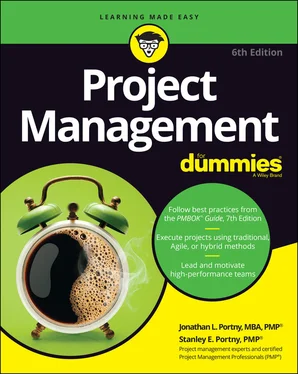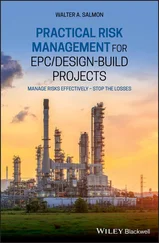Starting your stakeholder register
A project stakeholder register is a living document. You need to start developing your register as soon as you begin thinking about your project.
Begin your project’s stakeholder register by considering the initial version of the register that’s generated upon completion of the development of the project charter (see Chapter 3for more on this topic). Next, write down any other names that occur to you. When you discuss your project with other people, ask them who they think may be affected by or interested in your project. Then select a small group of the stakeholders you identify and conduct a formal brainstorming session. Continue to add and subtract names to your stakeholder register until you can’t think of anyone else.
In the following sections, we explain how to refine your stakeholder register by dividing it into specific categories and recognizing important potential stakeholders; we wrap up with a sample to show you how to put your own register together.
Using specific categories
To increase your chances of identifying all appropriate people, develop your stakeholder register in categories. You’re less likely to overlook people when you consider them department by department or group by group instead of trying to identify everyone from the organization individually at the same time.
 Start your stakeholder register by developing a hierarchical grouping of categories that covers the universe of people who may be affected by, be needed to support, or be interested in your project. We often start with the following groups:
Start your stakeholder register by developing a hierarchical grouping of categories that covers the universe of people who may be affected by, be needed to support, or be interested in your project. We often start with the following groups:
Internal: People and groups inside your organization:Executive leadership: Typically C-level or VP-level management responsible for the general oversight of all organization operationsRequesters: The person who came up with the idea for your project and all the people through whom the request passed before you received itProject manager: The person with overall responsibility for successfully completing the projectEnd users: People who will use the goods or services the project will produceTeam members: People assigned to the project whose work the project manager directsUNDERSTANDING THE STAKEHOLDER REGISTER’S TRUE PURPOSEA number of years ago, we heard the story of a woman who had attended a very reputable project management training session and began to put her newfound learnings into practice. She was using several of the techniques discussed in the course and found them to be very helpful. However, after making a serious attempt to create a stakeholder register, she found this tool to be impractical and of little value.Her manager had assigned a project that she had to finish in two months. She immediately developed a stakeholder register, but, much to her horror, the register included more than 150 names! How, she wondered, was she supposed to involve more than 150 people in a two-month project? She concluded that the stakeholder register clearly was of no help.In fact, her stakeholder register had served its purpose perfectly. Identifying the people at the outset who would affect the success of her project gave her three options:She could plan how and when to involve each person during the project.She could assess the potential consequences of not involving one or more of her stakeholders.She could discuss extending the project deadline or reducing its scope with her manager if she felt she couldn’t ignore any of the stakeholders.The stakeholder register itself doesn’t decide whom you should involve in your project. Instead, it specifies those people who may affect the success of your project so you can weigh the benefits and the costs of including or omitting them.Groups normally involved: Groups typically involved in most projects in the organization, such as the human resources, finance, contracts, and legal departmentsGroups needed just for this project: Groups or people with special knowledge related to this project
External: People and groups outside your organization:Clients or customers: People or groups that buy or use your organization’s products or servicesCollaborators: Groups or organizations with whom you may pursue joint ventures related to your projectVendors, suppliers, and contractors: Organizations that provide personnel, raw materials, equipment, or other resources required to perform your project’s workRegulators: Government agencies that establish regulations and guidelines that govern some aspect of your project workProfessional societies: Groups of professionals that may influence or be interested in your projectThe public: The local, national, and international community of people who may be affected by or interested in your project
 Continue to subdivide these categories further until you arrive at job titles (or position descriptions) and the names of the people who occupy them. (The process of systematically separating a whole into its component parts is called decomposition, which you can read about in Chapter 6.)
Continue to subdivide these categories further until you arrive at job titles (or position descriptions) and the names of the people who occupy them. (The process of systematically separating a whole into its component parts is called decomposition, which you can read about in Chapter 6.)
Considering stakeholders that are often overlooked
As you develop your stakeholder register, be sure not to overlook the following potential stakeholders:
Support groups: These people don’t tell you what you should do (or help you deal with the trauma of project management); instead, they help you accomplish the project’s goals. If support groups know about your project early, they can fit you into their work schedules more readily. They can also tell you information about their capabilities and processes that may influence what your project can accomplish and by when. Such groups include:Project management office (PMO)Quality assurance (QA)Finance (includes accounts payable/receivable)Human resources (HR)LegalProcurement (or contracting)Facilities (includes security and shipping/receiving)Information technology (IT)Call centers and help desksManufacturingEngineeringMarketing
End users of your project’s products: End users are people or groups who will use the goods and services your project produces. Involving end users at the beginning of and throughout your project helps ensure that the goods and services produced are as easy as possible to implement and use, and are most responsive to their true needs. It also confirms that you appreciate the fact that the people who will use a product may have important insights into what it should look like and do, which increases the chances that they’ll work to implement the products successfully.In some cases, you may omit end users on your stakeholder register because you don’t know who they are. In other situations, you may think you have taken them into account through liaisons — people who represent the interests of the end users (check out the nearby sidebar “Discovering the real end users” for a costly example of what can happen when you depend solely on liaisons).
People who will maintain or support the final product: People who will service your project’s final products affect the continuing success of these products. Involving these people throughout your project gives them a chance to make your project’s products easier to maintain and support. It also allows them to become familiar with the products and effectively build their maintenance into existing procedures.
DISCOVERING THE REAL END USERS
A major international bank based in the United States had spent millions of dollars revising and upgrading its information system. Project personnel had worked closely with special liaisons in Europe who represented the interests of the local bank personnel who would actually be entering and retrieving data from the new system. When the bank introduced the upgraded system, they discovered a fatal problem: More than 90 percent of the local bank personnel in Europe were non-English speaking, but the system documentation was all written in English. The enhanced systems were unusable!
Читать дальше

 Start your stakeholder register by developing a hierarchical grouping of categories that covers the universe of people who may be affected by, be needed to support, or be interested in your project. We often start with the following groups:
Start your stakeholder register by developing a hierarchical grouping of categories that covers the universe of people who may be affected by, be needed to support, or be interested in your project. We often start with the following groups: Continue to subdivide these categories further until you arrive at job titles (or position descriptions) and the names of the people who occupy them. (The process of systematically separating a whole into its component parts is called decomposition, which you can read about in Chapter 6.)
Continue to subdivide these categories further until you arrive at job titles (or position descriptions) and the names of the people who occupy them. (The process of systematically separating a whole into its component parts is called decomposition, which you can read about in Chapter 6.)










